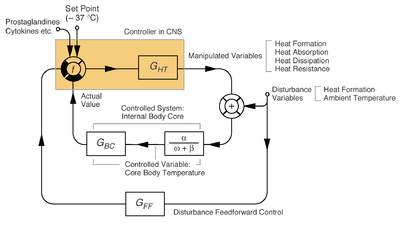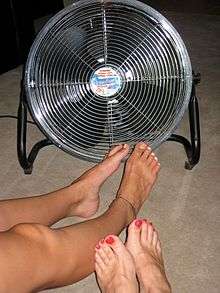Thermoregulation in humans
As in other mammals, thermoregulation in humans is an important aspect of homeostasis. In thermoregulation, body heat is generated mostly in the deep organs, especially the liver, brain, and heart, and in contraction of skeletal muscles.[1] Humans have been able to adapt to a great diversity of climates, including hot humid and hot arid. High temperatures pose serious stress for the human body, placing it in great danger of injury or even death. For humans, adaptation to varying climatic conditions includes both physiological mechanisms resulting from evolution and behavioural mechanisms resulting from conscious cultural adaptations.[2][3]
There are four avenues of heat loss: convection, conduction, radiation, and evaporation. If skin temperature is greater than that of the surroundings, the body can lose heat by radiation and conduction. But, if the temperature of the surroundings is greater than that of the skin, the body actually gains heat by radiation and conduction. In such conditions, the only means by which the body can rid itself of heat is by evaporation. So, when the surrounding temperature is higher than the skin temperature, anything that prevents adequate evaporation will cause the internal body temperature to rise.[4] During sports activities, evaporation becomes the main avenue of heat loss.[5] Humidity affects thermoregulation by limiting sweat evaporation and thus heat loss.[6]
Control system

The core temperature of a human is regulated and stabilized primarily by the hypothalamus, a region of the brain linking the endocrine system to the nervous system,[8] and more specifically by the anterior hypothalamic nucleus and the adjacent preoptic area regions of the hypothalamus. As core temperature varies from the set point, endocrine production initiates control mechanisms to increase or decrease energy production/dissipation as needed to return the temperature toward the set point (see figure).[7]
In hot conditions

- Eccrine sweat glands under the skin secrete sweat (a fluid containing mostly water with some dissolved ions), which travels up the sweat duct, through the sweat pore and onto the surface of the skin. This causes heat loss via evaporative cooling; however, a lot of essential water is lost.
- The hair on the skin lie flat, preventing heat from being trapped by the layer of still air between the hair. This is caused by tiny muscles under the surface of the skin called arrector pili muscles relaxing so that their attached hair follicles are not erect. These flat hairs increase the flow of air next to the skin increasing heat loss by convection. When environmental temperature is above core body temperature, sweating is the only physiological way for humans to lose heat.
- Arteriolar vasodilation occurs. The smooth muscle walls of the arterioles relax allowing increased blood flow through the artery. This redirects blood into the superficial capillaries in the skin increasing heat loss by convection and conduction.
In hot and humid conditions
In general, humans appear physiologically well adapted to hot dry conditions.[9] However, effective thermoregulation is reduced in hot, humid environments such as the Red Sea and Persian Gulf (where moderately hot summer temperatures are accompanied by unusually high vapor pressures), tropical environments, and deep mines where the atmosphere can be water-saturated.[9][2] In hot-humid conditions, clothing can impede efficient evaporation.[3] In such environments, it helps to wear light clothing such as cotton, that is pervious to sweat but impervious to radiant heat from the sun. This minimizes the gaining of radiant heat, while allowing as much evaporation to occur as the environment will allow. Clothing such as plastic fabrics that are impermeable to sweat and thus do not facilitate heat loss through evaporation can actually contribute to heat stress.[6]
In cold conditions
- Heat is lost mainly through the hands and feet.
- Sweat production is decreased.
- The minute muscles under the surface of the skin called arrector pili muscles (attached to an individual hair follicle) contract (piloerection), lifting the hair follicle upright. This makes the hairs stand on end, which acts as an insulating layer, trapping heat. This is what also causes goose bumps since humans do not have very much hair and the contracted muscles can easily be seen.
- Arterioles carrying blood to superficial capillaries under the surface of the skin can shrink (constrict), thereby rerouting blood away from the skin and towards the warmer core of the body. This prevents blood from losing heat to the surroundings and also prevents the core temperature dropping further. This process is called vasoconstriction. It is impossible to prevent all heat loss from the blood, only to reduce it. In extremely cold conditions, excessive vasoconstriction leads to numbness and pale skin. Frostbite occurs only when water within the cells begins to freeze. This destroys the cell causing damage.
- Muscles can also receive messages from the thermoregulatory center of the brain (the hypothalamus) to cause shivering. This increases heat production as respiration is an exothermic reaction in muscle cells. Shivering is more effective than exercise at producing heat because the animal (includes humans) remains still. This means that less heat is lost to the environment through convection. There are two types of shivering: low-intensity and high-intensity. During low-intensity shivering, animals shiver constantly at a low level for months during cold conditions. During high-intensity shivering, animals shiver violently for a relatively short time. Both processes consume energy, however high-intensity shivering uses glucose as a fuel source and low-intensity tends to use fats. This is a primary reason why animals store up food in the winter.
- Brown adipocytes are also capable of producing heat via a process called non-shivering thermogenesis. In this process, triglycerides are burned into heat, thereby increasing body temperature.
Uses of hypothermia
Adjusting the human body temperature downward has been used therapeutically, in particular, as a method of stabilizing a body following trauma. It has been suggested that adjusting the A1 receptor of the hypothalamus may allow humans to enter a hibernation-like state of reduced body temperature, which could be useful for applications such as long-duration space flight.[10]
Related diseases and syndromes
Human heat output power
Humans output from 70 watts to 870 watts, depending on the amount of physical activity undertaken.[11]
References
- Guyton, A.C., & Hall, J.E. (2006). Textbook of Medical Physiology (11th ed.). Philadelphia: Elsevier Saunders. p. 890.CS1 maint: multiple names: authors list (link)
- Harrison, G.A., Tanner, J.M., Pilbeam, D.R., & Baker, P.T. (1988) Human Biology: An introduction to human evolution, variation, growth, and adaptability. (3rd ed). Oxford: Oxford University Press
- Weiss, M.L., & Mann, A.E. (1985) Human Biology and Behaviour: An anthropological perspective. (4th ed). Boston: Little Brown
- Guyton & Hall (2006), pp.891-892
- Wilmore, Jack H., & Costill, David L. (1999). Physiology of sport and exercise (2nd ed). Champaign, Illinois: Human Kinetics.
- Guyton, Arthur C. (1976) Textbook of Medical Physiology. (5th ed). Philadelphia: W.B. Saunders
- Kanosue, K., Crawshaw, L. I., Nagashima, K., & Yoda, T. (2009). Concepts to utilize in describing thermoregulation and neurophysiological evidence for how the system works. European Journal of Applied Physiology, 109(1), 5–11. doi:10.1007/s00421-009-1256-6
- Robert M. Sargis, An Overview of the Hypothalamus: The Endocrine System’s Link to the Nervous System (accessed Jan. 19 2015)
- Jones, S., Martin, R., & Pilbeam, D. (1994) The Cambridge Encyclopedia of Human Evolution". Cambridge: Cambridge University Press
- Jason Koebler, A Brief History of Cryosleep, Motherboard, January 19, 2016 (accessed Jan. 19 2015)
- Binggeli, Corky (2009-06-09). Building Systems for Interior Designers. ISBN 9780470228470.